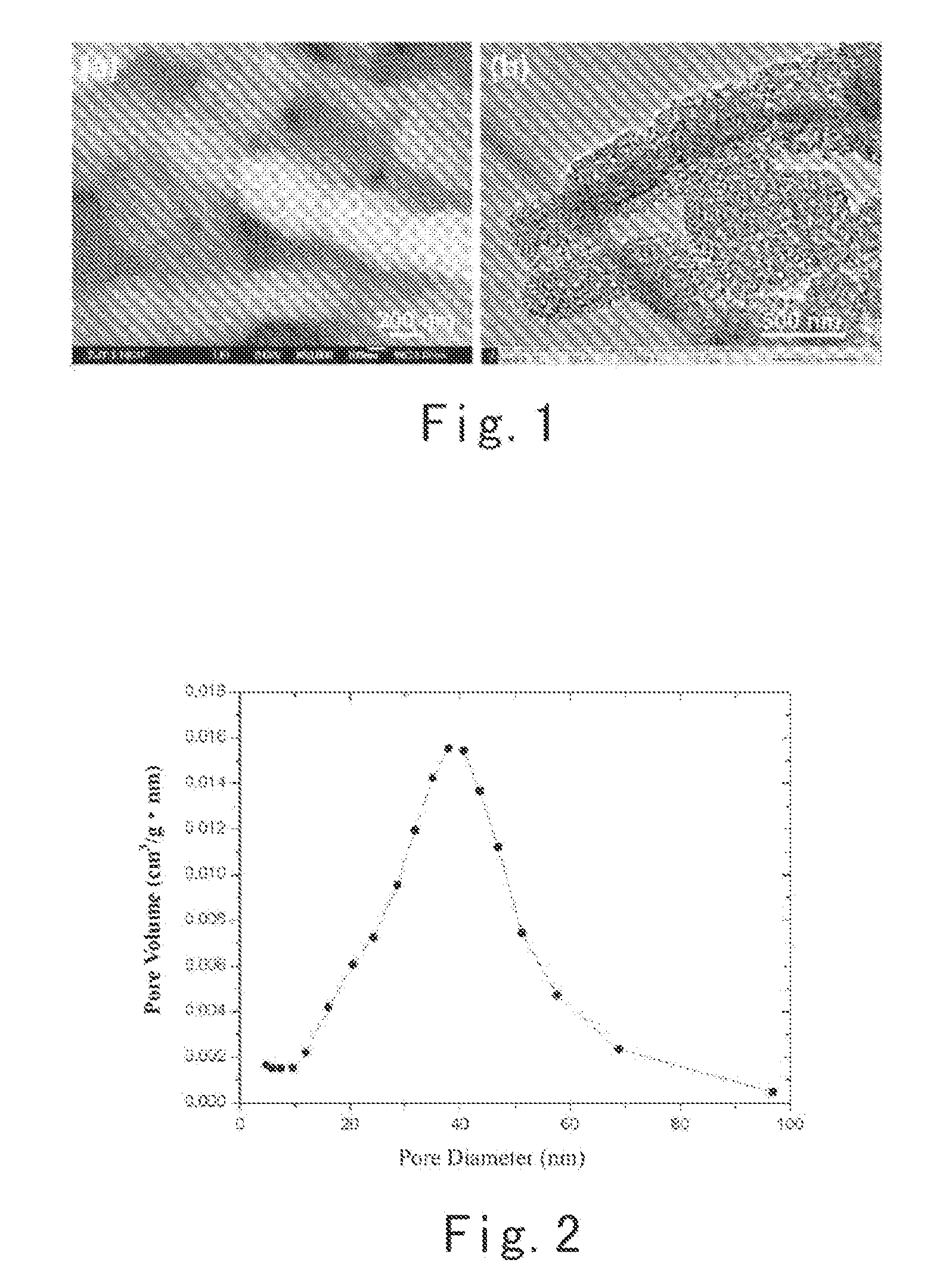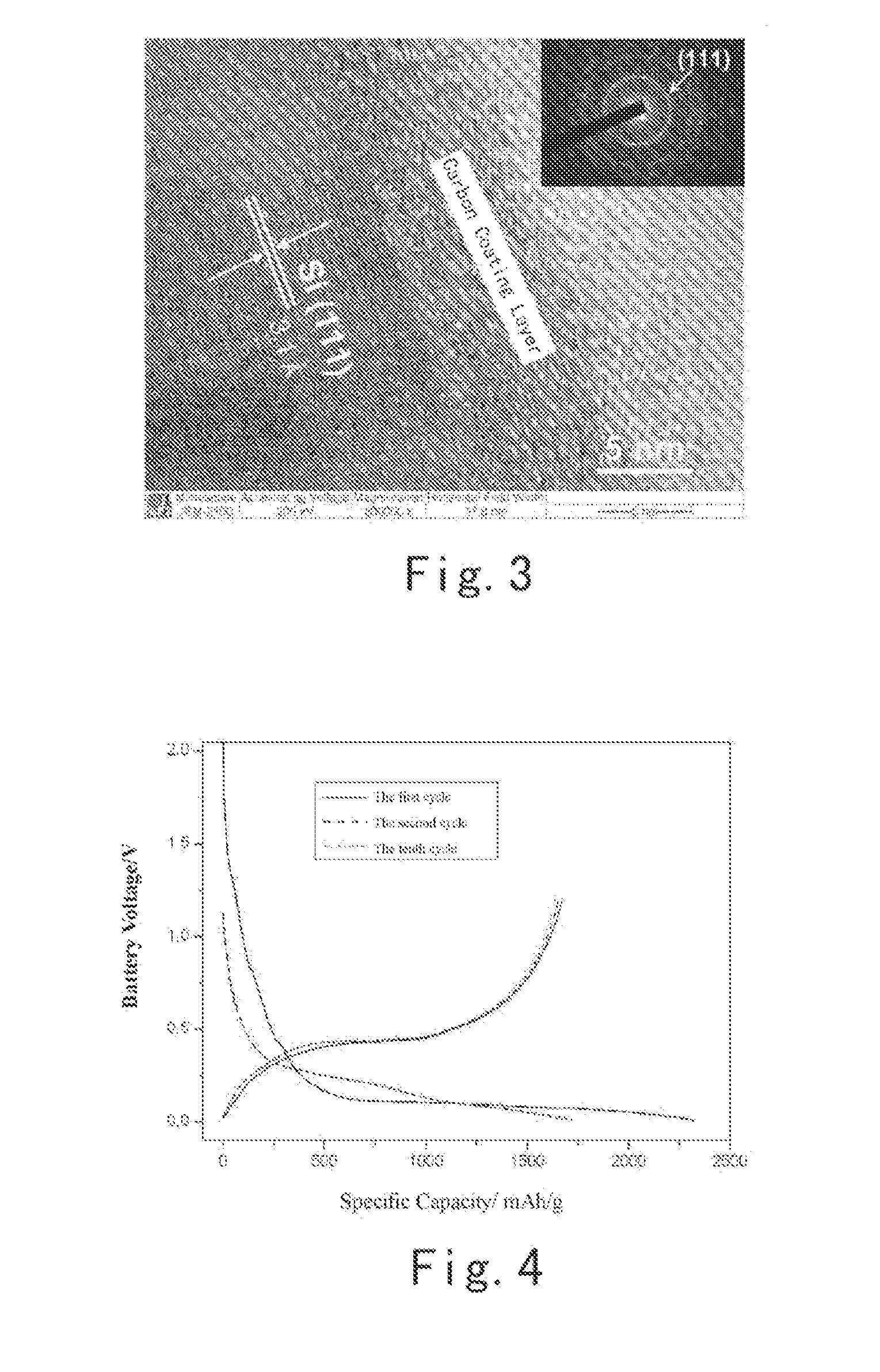Silicon-carbon Composite Anode Material for Lithium Ion Batteries and A Preparation Method Thereof
a lithium ion battery and composite anode technology, applied in the field of lithium ion battery battery composite anode material and a preparation method, can solve the problems of not meeting the development requirements of the new generation of high-capacity lithium ion batteries, limiting commercial applications, and 372 mah/g, and achieve excellent cycle stability and rate performance, high capacity, and low cost.
- Summary
- Abstract
- Description
- Claims
- Application Information
AI Technical Summary
Benefits of technology
Problems solved by technology
Method used
Image
Examples
example 1
[0039]Preparation of mesoporous silica: 4.0 g of ethylene oxide / propylene oxide block copolymer (tradename: Pluronic P123) was dissolved in a mixed solution of 30.0 g of water and 120.0 g of hydrochloric acid (2 mol / L), after being stirred homogeneously, 8.4 g of tetraethyl orthosilicate (TEOS) was added therein. The mixture was then stirred at 35° C. for 24 hours and transferred into a hydrothermal reaction kettle where the temperature was kept at 100° C. for 24 hour. After being cooled, the mixture was centrifugalized at 4000 r / min, dried at 95° C., and then calcined at 550° C. in an air atmosphere for 2 hours. Thus, mesoporous silica was obtained.
[0040](1) 0.3 g of mesoporous silica and 0.3 g of magnesium powder were placed in a high temperature furnace. In a gas mixture of argon and hydrogen (the content of hydrogen was 5% by volume), the temperature was raised to 650° C., and temperature was kept for 7 hours before it was allowed to cool. Then the materials were put into 25 ml ...
example 2
[0044]Preparation of mesoporous silica: 3.0 g of Pluronic P123 was dissolved in a mixed solution of 22.5 g of water, 3.0 g of 1-butanol and 90.0 g of hydrochloric acid (2 mol / L), after being stirred homogeneously, 6.3 g of TEOS was added therein. The mixture was then stirred at 35° C. for 24 hours and transferred into a hydrothermal reaction kettle where the temperature was kept at 100° C. for 24 hour. After being cooled, the mixture was centrifugalized at 4000 r / min, dried at 100° C., and then calcined at 600° C. in an air atmosphere for 2 hours. Thus, mesoporous silica was obtained.
[0045](1) 0.4 g of mesoporous silica and 0.4 g of magnesium powder were placed in a high temperature furnace. In an atmosphere of argon, the temperature was raised to 700° C., and temperature was kept for 6 hours before it was allowed to cool. Then the materials were put into 30 ml of hydrochloric acid (2 mol / L) and stirred for 12 hours. After 4 times of centrifugation at 4000 r / min, and vacuum drying a...
example 3
[0049]Preparation of mesoporous silica: 4.0 g of Pluronic P123 was dissolved in a mixed solution of 30.0 g of water, 4.0 g of 1-butanol and 120.0 g of hydrochloric acid (2 mol / L), after being stirred homogeneously, 8.4 g of TEOS was added therein. The mixture was then stirred at 35° C. for 24 hours and transferred into a hydrothermal reaction kettle where the temperature was kept at 100° C. for 24 hour. After being cooled, the mixture was centrifugalized at 4000 r / min, dried at 100° C., and then calcined at 600° C. in an air atmosphere for 2 hours. Thus, mesoporous silica was obtained.
[0050](1) 0.4 g of mesoporous silica and 0.4 g of magnesium powder were placed in a high temperature furnace. In a gas mixture of argon and hydrogen (the content of hydrogen was 5% by volume), the temperature was raised to 750° C., and temperature was kept for 7 hours before it was allowed to cool. Then the materials were put into 30 ml of hydrochloric acid (2 mol / L) and stirred for 12 hours. After 4 t...
PUM
| Property | Measurement | Unit |
|---|---|---|
| Temperature | aaaaa | aaaaa |
| Temperature | aaaaa | aaaaa |
| Temperature | aaaaa | aaaaa |
Abstract
Description
Claims
Application Information
 Login to View More
Login to View More - R&D
- Intellectual Property
- Life Sciences
- Materials
- Tech Scout
- Unparalleled Data Quality
- Higher Quality Content
- 60% Fewer Hallucinations
Browse by: Latest US Patents, China's latest patents, Technical Efficacy Thesaurus, Application Domain, Technology Topic, Popular Technical Reports.
© 2025 PatSnap. All rights reserved.Legal|Privacy policy|Modern Slavery Act Transparency Statement|Sitemap|About US| Contact US: help@patsnap.com



